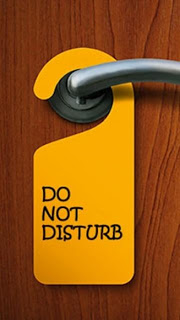-
Altering Tasks to Maintain Your Attention
by SebAug 21, 20130 CommentPhoto Courtesty of Dani and Susi at between2chairsblog
As we near the end of our series on strategies for coping with information overload, we’re ready to check out the simple but effective strategy of ‘altering. Altering means changing your perception of a task by performing it in a different way or place.
Everyone’s heard the phrase ‘a change is as good as a rest,’ but as with other well-known phrases, we rarely take the time to think about what it means and whether there is much truth behind it. In fact this is one saying that really hits the nail on the head (excuse the use of yet another cliché).
When we’re performing a task, we require something known as “directed attention” in order to process information related to that task. All too often the monotony of a task leads to directed attention fatigue, where we are no longer able to efficiently process information. One of the most effective ways to recover from that fatigue is to make small changes to the way we are working, stimulating different parts of the brain and restoring directed attention.
So what can you change?
You might think that the tasks you perform at work are pretty routine, with little scope for altering, but you’d be surprised how much of a difference small changes can make to your perception of what you need to do.
- Location. Even a slight change of location, such as turning your desk around or moving to a different part of your office, can help restore your attention. For a more extreme change, move to a coffee shop or other public place where there will be new stimuli for your brain. According to Attention Restoration Theory, nature is particularly powerful in helping us recover from directed attention fatigue. Working outside could be an option. Clouds in the sky, plants and flowers, birds in flight, and flowing water can all help restore attention.
- Media. Most of us now spend an inordinate amount of time seated in front of a computer, and almost all tasks are done digitally. Just consider for a moment the other types of media you could combine with your computer screen. When you’re taking notes, why not use a pen and paper or even a Dictaphone rather than a word processor. If you have to read or edit a document, decide whether you’d rather print it off or read it on the screen. If you need to brainstorm, get out the old flip chart or a white board and some magic markers. The experience can be strangely liberating.
- Environment. In our last article on ‘escaping’ we looked at the issue of noise in the workplace. If noise is a distraction for you, think about finding somewhere quieter to work or using sound reducing headphones. On the other hand you may feel that your work environment is too quiet. Switching on the radio, or just playing some background music while you’re working can stimulate your brain and help reduce attention fatigue. Also consider the temperature and air flow of your workspace. Perhaps you just need to open a window.
- Schedule. Is the task you have to complete really as dull as you think it is, or does the fact that you always do it during your 2:00 PM energy slump have an impact? Try switching your schedule so that you complete the task first thing in the morning with a cup of coffee. You might find you can do it quicker and more easily, and you might even enjoy it. If not, at least you don’t have to spend the rest of the day dreading it.
-
Escaping the Information Deluge
by SebAug 14, 2013Although we are looking at eleven strategies for coping with information overload, they aren’t necessarily suitable to use all at once. This week’s strategy may be seen as the opposite of multitasking and is known as escaping. It is the ideal strategy to adopt when you need to cut out all distractions and focus 100% on one immensely important task.

Photo Courtesy of http://btclounge.blogspot.ch/ Escaping is eliminating disturbances by psychologically or physically limiting disruptions from the outside world.
Disruptions and distractions cost time and productivity. Every time you are distracted, you lose focus on the task at hand, making you lose valuable time. You may even end up repeating finished work.
However, distractions have a far greater impact than we realise. Chronic disruptions in the workplace make it difficult to concentrate, think deeply, and be creative. This causes work place conflicts, inadequate performance, missed deadlines, poor customer relationships, and ultimately lost business.
The variety of distractions we are exposed to in the workplace are growing with the digital age. Along with traditional distractions, such as ad hoc meetings and talking with colleagues, we now have e-mail, text messages, instant messaging, and social media updates vying for our attention.
A 2011 survey on electronic distractions in the workplace conducted by Harmon.ie discovered that:
- 45% of employees only work for 15 minutes or less before getting interrupted
- 53% of employees waste an hour a day due to all types of distractions
- 57% of distractions are electronic, for example e-mails or instant messages
- 43% of distractions are personal, for example colleague queries or phone calls
The survey also showed that employees were likely to become distracted while switching between different applications and screens on their computer. 45% of employees said they usually had at least six items open simultaneously, and switched between all of these.
-
Delegating Is a Win Win Strategy
by SebJul 31, 2013So far we’ve learned some important skills for coping with information overload and increasing our productivity: prioritising, multitasking, and queuing. But what if your workload is so overwhelming that you find these strategies lacking?
The seventh part of our guide on coping with information overload should help you with decreasing your own workload, and should enable you to focus on the really important parts of your job. It discusses the art of delegating.
“Delegation is about entrusting others with appropriate responsibility and authority for the operation and / or accomplishment of certain activities.” — Chartered Management Institute
By learning to delegate you can identify work tasks that can and should be taken on by someone else. This will usually be someone in a team that you manage, or an employee of your own business.
Delegating benefits for delegators, or managers, by reducing their workload and allowing them to share tasks, making the whole team or business more productive. Delegating can prevent managers from becoming overburdened and stressed, and can allow them to focus on business strategy rather than everyday operational tasks.
What many managers fail to realise is that delegation is also beneficial to those being delegated to. Managers often feel that by taking on tasks themselves, or by solving all issues themselves, their employees will feel that they are being helped and supported. In fact the opposite is usually true. When a managers fails to delegate, their team frequently feels untrusted, undervalued, or undermined. If their manager has low expectations of them, they will tend to fulfil these expectations.
If employees aren’t required or allowed to think for themselves–to reach their own solutions–they will become dissatisfied and unmotivated, depriving the business of ideas and input. On the other hand, managers who empower their employees to work independently find they have more committed and creative staff.
-
Create a Smooth Workflow Using Queuing
by SebJul 24, 2013In the modern workplace we’re expected to perform a huge number and variety of tasks. We’ve already looked at prioritising and multitasking as strategies for coping with increased work demands, and now we’re going to investigate another useful strategy which: queuing.
In Information Overload: Causes, Symptoms, and Solutions, Joseph Ruff defined queuing as “performing initial steps to tasks that will be completed at a later time.”
This is a different definition of queuing from the one we are used to, where individuals wait in line to be attended to. However there are many parallels that we can draw between the two, and lessons that can be learned about how to manage a queue.
Picture courtesy of http://www.growhill.com/
Imagine for a minute a poorly managed physical queue. While you’re desperately dealing with one customer, you have a hoard of others demanding your attention, asking questions, shouting out, and trying to get to the front. This will affect your ability to deal with the customer in front of you, increasing waiting times, and aggravating the customers waiting in line even more.
On the other hand, think of a calm, well-organised queue with patient customers that allow you to focus on what you are doing. A good queuing strategy results in a smooth flow of customers, shorter waiting times, and a less stressful situation. The same can be said for a work queue. A well-arranged queue of tasks can provide a smooth flow of information, a quicker and more efficient way of working, and a far less stressful working environment.
So how do you create a well organised work queue?







